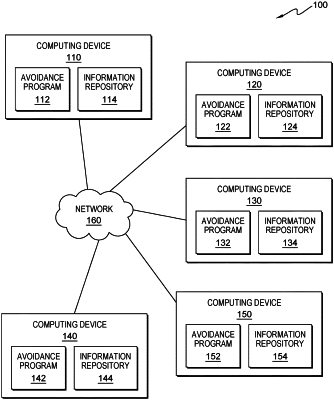| CPC B60W 30/0956 (2013.01) [B60W 30/0953 (2013.01); G01C 21/3492 (2013.01); G06V 20/588 (2022.01); G08G 1/081 (2013.01); G08G 1/091 (2013.01); H04W 4/46 (2018.02)] | 25 Claims |

|
1. A computer-implemented method for collaborative accident prevention, the computer-implemented method comprising:
receiving, by one or more computer processors, a first vehicle information vector associated with a first trajectory of a first vehicle approaching an intersection, wherein the first vehicle information vector contains at least a first vehicle speed, a first vehicle position, and a first vehicle direction;
receiving, by the one or more computer processors, a second vehicle information vector associated with a second trajectory of a second vehicle also approaching the intersection, wherein the second vehicle information vector contains at least a second vehicle speed, a second vehicle position, and a second vehicle direction;
calculating, by the one or more processors, a projected arrival time at which each of the first vehicle and the second vehicle enters the intersection based on the first vehicle information vector and the second vehicle information vector;
adding, by the one or more processors, a safety factor to the projected arrival time and determining if the second vehicle reaches the intersection after a projected exit time of the first vehicle plus the safety factor;
responsive to the second vehicle reaching the intersection before the first vehicle has left the intersection plus the safety factor, determining, by the one or more processors, that a collision is possible and calculating a priority to cross the intersection of the first vehicle and a priority to cross the intersection of the second vehicle;
responsive to the priority of the first vehicle being the same as the priority of the second vehicle, calculating, by the one or more processors, a first adjusted vehicle speed for the first vehicle and a second adjusted vehicle speed for the second vehicle to avoid the collision;
calculating, by the one or more processors, a first combined cost of energy consumption, carbon footprint, and traffic flow for the first adjusted vehicle speed and a second combined cost of energy consumption, carbon footprint, and traffic flow for the second adjusted vehicle speed; and
based on the first combined cost for the first vehicle being larger than the second combined cost for the second vehicle, displaying, by the one or more processors, a message on a dashboard of the first vehicle to prompt a first driver of the first vehicle to change the first vehicle speed to the first adjusted vehicle speed.
|